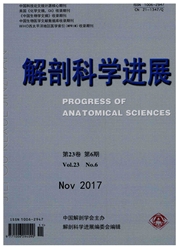

 中文摘要:
中文摘要:
目的探讨全反式维甲酸(ATRA)对大鼠脑缺血再灌注后血脑屏障通透性和紧密连接蛋白ZO-1的影响。方法选取180只健康雄性大鼠,随机分为假手术组(Sham,60只),缺血再灌注组(I/R,60只)和全反式维甲酸干预组(ATRA,60只),每组又细分为1d、3d和7d三个亚组。采用ZeaLonga法制作局灶性脑缺血再灌注模型,伊文思蓝渗透性实验检测血脑屏障通透性变化,免疫组织化学方法法和Westernblot方法检测各组大鼠脑组织ZO-1蛋白的表达,Real-timePCR方法检测各组大鼠脑组织ZO-lmRNA的表达。结果缺血再灌注后,EB含量在1d时含量最高,3d时开始逐渐下降,而与相同时间点的I/R组相比,ATRA组EB含量显著降低(P〈0.01)。与Sham组相比,I/R组大鼠脑组织ZO-1蛋白及mRNA的表达水平均显著降低(P〈0.01),而与相同时间点的I/R组相比,ATRA组大鼠脑组织ZO-1蛋白及mRNA的表达水平均显著升高。结论全反式维甲酸降低大鼠脑缺血再灌注血脑屏障通透性可能与上调脑缺血再灌注后脑组织中ZO-1的表达相关。
 英文摘要:
英文摘要:
Objective To study the effect of all-trans retinoic acid(ATRA) on the permeability of blood brain barrier and the expression of ZO-I in cerebral isehemia-reperfusion rats. Methods 180 healthy male rats were randomly divided into sham group, isehemia-reperfusion group(I/R) group, and all-trans retinoic acid(ATRA)group at different time points (ld,3d and 7d) on average. The rat model of focal cerebral I/R injury was established by Zea Longa's method, the blood brain barrier(BBB) permeability was assessed by evans blue extravasation, The changes of ZO-1 protein and mRNA were detected by immunohistochemistry method, Western blot method, and real-time PCR, respectively. Results The content of Evans blue(EB) in brain tissue reached a peak at 1 d after cerebral I/R and gradually decreased afterwards, and decreased significantly in ATRA group than in I/R group at the same time points. The expression levels of ZO-1 protein and mRNA were decreased significantly in I/R group than in sham group, but increased in ATRA group than in I/R group at the same time points(P〈0.01). Conclusion The decreased BBB permeability by ATRA in brain tissue might be related to increasing the expression of ZO-1 in I/R rat.
 同期刊论文项目
同期刊论文项目
 同项目期刊论文
同项目期刊论文
 期刊信息
期刊信息
